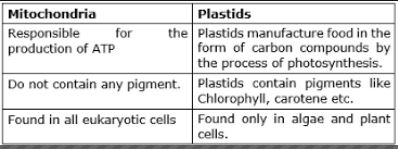What is Difference Between Mitochondria And Plastids?
Difference Between Mitochondria And Plastids is that Mitochondria occur in most animal and plant cells, but plastids do not occur in any animal cell.
Mitochondria have crests and matrix, but plastids do not have crests or the same type of matrix. Chloroplasts have thylakoids and stroma.
All mitochondria have internal membranes, but only some plastids have internal membranes.
Plastids may vary in color, however, mitochondria do not vary in color.
Some plastids are adapted to store biological macromolecules, while mitochondria are not adapted to store biological macromolecules.
Mitochondria play a role in thermogenesis, while plastids do not play a role in thermogenesis.
Plastids can participate in glucose production through photosynthesis, but mitochondria do not participate in glucose production.
Mitochondria and chloroplasts are the energy organelles of eukaryotic cells. Remember that eukaryotes are cells that have a defined nucleus. These types of cells are those that are present in the vast majority of living things. That said, mitochondria and chloroplasts have specific functions depending on the type of cell where they are present.
Mitochondria
It can be said that mitochondria are organelles available in almost all eukaryotic cells. They are responsible for providing the energy required for cellular activity. Therefore, they are considered the power plant of the cell. In addition, they are responsible for synthesizing ATP through oxidative phosphorylation.
On the other hand, the mitochondria have two membranes and two internal compartments (intermembrane space and matrix), the inner membrane has ridges that separate the mitochondria into two sections; a matrix, and an intermembrane space. The function of mitochondria is aerobic respiration of cells, duplication of mitochondrial DNA and mitochondrial respiration.
Chloroplasts
In a simple way, chloroplasts are organelles that have a large delimited membrane. Therefore, these can only be found in those eukaryotic cells that fulfill the process of photosynthesis. That is plant cells and green algae and originates from photosynthetic bacteria. Thus, from its name, it can be deduced that they contain chlorophyll. For this reason, chloroplasts take advantage of sunlight to synthesize sugars and ATP to feed.
Also, these organelles are made up of three membranes. Among them, we mention the external, internal and helicoidal. They divide three internal compartments such as the stroma, intermembrane space, and the helicoidal space. In this space or helicoidal membrane is where the photosynthetic chain is given by photosynthetic phosphorylation.
Difference between Mitochondria and Chloroplasts
| Mitochondria | Chloroplasts |
| Mitochondria are present in animal and plant cells. | Chloroplasts are found exclusively in plant cells. |
| They originate from aerobic bacteria. | They originate from photosynthetic bacteria. |
| Its function is aerobic respiration of cells. | Its function is photosynthesis. |
| They have two membranes and two internal compartments. | They have three membranes (external, internal and tilacoidal) that delimit three compartments. |
| In the inner membrane, the respiratory chain is given by oxidative phosphorylation. | In the helicoidal membrane, the photosynthetic chain is given by photosynthetic phosphorylation. |
You May Also Interested:
